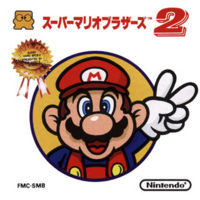Difference between revisions of "Super Mario Bros. 2 (Japan)"
(Undo revision 6206 by Special:Contributions/GORE-ILLA (User talk:GORE-ILLA)) |
|||
| Line 7: | Line 7: | ||
|publisher=[[Nintendo]] | |publisher=[[Nintendo]] | ||
|system=[[NES]] ([[Famicom Disk System]])<br /> [[Gameboy Advance]]<br />[[Virtual Console]] | |system=[[NES]] ([[Famicom Disk System]])<br /> [[Gameboy Advance]]<br />[[Virtual Console]] | ||
| − | |release='''[[NES]]'''<br />JP | + | |release='''[[NES]]'''<br />JP June 13, 1986<br />'''[[GBA]]'''<br />JP August 10, 2004<br />[[Virtual Console]]<br />JP May 1, 2007<br />AU September 14, 2007 |
|gallery= | |gallery= | ||
|rating= | |rating= | ||
| Line 33: | Line 33: | ||
*It was included in an unlockable on the 1999 [[Gameboy Color]] game [[Super Mario Bros. DX]]. This version, graphically identical to the original, was called "Super Mario Bros. For Super Players". Only the first eight worlds are playable in this release. Other differences including Mario and Luigi no longer being statistically different, and the removal of the winds. | *It was included in an unlockable on the 1999 [[Gameboy Color]] game [[Super Mario Bros. DX]]. This version, graphically identical to the original, was called "Super Mario Bros. For Super Players". Only the first eight worlds are playable in this release. Other differences including Mario and Luigi no longer being statistically different, and the removal of the winds. | ||
*In 2004, the original version was released on the [[Gameboy Advance]] in Japan as part of the [[Classic NES Series|Famicom Mini]] series. | *In 2004, the original version was released on the [[Gameboy Advance]] in Japan as part of the [[Classic NES Series|Famicom Mini]] series. | ||
| + | *It was released for the Japanese [[Virtual Console]] in 2007. It was later released for the Australian Virtual Console in celebration of the Japanese Hanabi Festival on September 14, 2007. However, it is only available until the end of the festival on September 30, 2007. This was the first Virtual Console game with a limited release. | ||
[[Category: Video Games]] [[Category: NES Games]] [[Category: Gameboy Advance Games]] [[Category: Mario Games]] [[Category: Classic NES series]] | [[Category: Video Games]] [[Category: NES Games]] [[Category: Gameboy Advance Games]] [[Category: Mario Games]] [[Category: Classic NES series]] | ||
Revision as of 19:53, 14 September 2007

| |
| Super Mario Bros. 2 | |
| Developer | Nintendo EAD |
| Publisher | Nintendo |
| System | NES (Famicom Disk System) Gameboy Advance Virtual Console |
| Release Date | NES JP June 13, 1986 GBA JP August 10, 2004 Virtual Console JP May 1, 2007 AU September 14, 2007 |
Super Mario Bros. 2 (or Lost Levels) is actually the Japanese sequel to Super Mario Bros. that was released as a part of the Famicom Disk System. However, the game was believed to be too hard for American gamers, so a different game called Super Mario Bros. 2 was developed for release in America and Europe from the Japanese game Yume Kōjō: Doki Doki Panic. However, the Japanese Super Mario Bros. 2 was later released in America as part of Super Mario All-Stars, where it was dubbed "Super Mario Bros.: The Lost Levels".
Information
The game is made from the same engine as the original Super Mario Bros., so the two share many similarities. However, The Lost Levels is designed to be much harder than the first. New enemies include flying Bloopers, Piranha Plants that emerge from pipes even if someone is standing on them and additional clones of Bowser appearing in fortresses. There are also new obstacles such as Poison Mushrooms, springboards that propel the brothers offscreen, Warp Zones with pipes that can send you backwards to previous worlds and winds that blow the brothers away. All enemies and power-ups from the first game also return.
The game also follows a similar format as the original Super Mario Bros. However, this time the player can choose to play as either Mario or Luigi, who are statistically different for the first time. The game also has nine worlds instead of the original's eight (although the ninth world can only be reached by beating the first eight worlds without Warp Zones). Four extra worlds, called Courses A-D can also be unlocked.
Legacy
Two notable elements of this game found their way into later titles. The first was the distinguishing of Luigi from Mario in terms of statistics. Secondly, it introduced the Poison Mushroom, which would make appearances in several later Mario games.
Sequels
The game was followed up by Super Mario Bros. 3.
Ports and Remakes
- In 1993 it was released on Super Mario All-Stars for the Super Nintendo as "Super Mario Bros.: The Lost Levels". This version boasted updated, Super Mario World-like graphics. This format was the first time it was released in America.
- It was included in an unlockable on the 1999 Gameboy Color game Super Mario Bros. DX. This version, graphically identical to the original, was called "Super Mario Bros. For Super Players". Only the first eight worlds are playable in this release. Other differences including Mario and Luigi no longer being statistically different, and the removal of the winds.
- In 2004, the original version was released on the Gameboy Advance in Japan as part of the Famicom Mini series.
- It was released for the Japanese Virtual Console in 2007. It was later released for the Australian Virtual Console in celebration of the Japanese Hanabi Festival on September 14, 2007. However, it is only available until the end of the festival on September 30, 2007. This was the first Virtual Console game with a limited release.